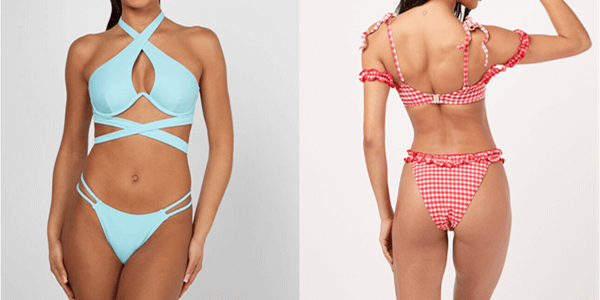
Trajes de baño versus lencería: Comparación de telas para comodidad y funcionalidad
Los trajes de baño y la lencería son dos tipos de ropa que requieren diferentes tipos de telas para ser funcionales y cómodas. La siguiente es una comparación de las telas más utilizadas para trajes de baño y lencería:
| Tela | Trajes de baño | Lencería |
|---|---|---|
| Nylon | ✔️ | ✔️ |
| Poliéster | ✔️ | ✔️ |
| Spandex | ✔️ | ✔️ |
| Algodón | ❌ | ✔️ |
| Seda | ❌ | ✔️ |
| Lino | ❌ | ✔️ |
| Seda artificial | ❌ | ✔️ |
| Modal | ❌ | ✔️ |
| Bambú | ❌ | ✔️ |
Telas Sintéticas
El nailon, el poliéster y el spandex son las tres telas sintéticas más utilizadas para trajes de baño y lencería. Son conocidos por su alta elasticidad, durabilidad y resistencia al daño causado por la exposición al sol, al agua salada y al cloro. Además, brindan un buen soporte, compresión y retención de la forma, lo que los hace ideales para ambos tipos de ropa.
Fibras Naturales
Cotton, silk, linen, and wool are natural fibers commonly used in lingerie but not swimwear. Cotton is breathable, soft, and comfortable, but it absorbs water and takes a long time to dry, which makes it unsuitable for swimwear. Silk is a luxurious and lightweight material that is comfortable to wear but not as durable or quick-drying as synthetic materials, making it unsuitable for swimwear. Linen is a light and breathable fabric that is comfortable to wear but does not provide enough stretch or support for swimwear. Wool is warm and comfortable but not quick-drying and absorbs water, making it unsuitable for swimwear.
Otros materiales
Además de las telas enumeradas anteriormente, otros materiales que a veces se usan para trajes de baño y lencería incluyen rayón, modal y bambú. Estos materiales están hechos de fibras naturales, pero a menudo se mezclan con materiales sintéticos para mejorar su durabilidad, elasticidad y propiedades de secado rápido.
Unique Treatments and Processing Methods
Regarding swimwear, several unique treatments and processing methods are used on fabrics to make them suitable for use in the water. For example, swimwear fabrics are often treated with chemicals such as chlorine-resistant finishes, UV protectants, and water repellents to improve their durability, protect against fading, and repel water. Swimwear fabrics are often made using specialized weaving techniques that provide extra stretch and support, such as circular or warp knit.
Conclusión
Choosing a suitable fabric for swimwear and lingerie is crucial for comfort and performance. By understanding the properties of different fabrics and their processing methods, you can select the appropriate material for the proper purpose and ensure that your clothing is comfortable, durable, and functional. Synthetic materials like nylon, polyester, and spandex are ideal for swimwear, while natural fibers like cotton, silk, and linen are preferred for lingerie.
